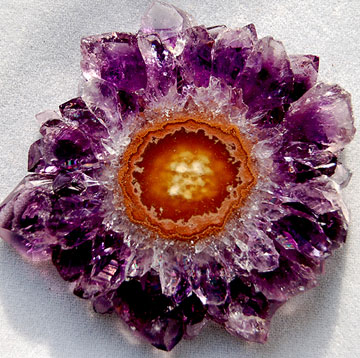
Chemical Eye on Songs of Innocence
and Experience
by PRESTON MACDOUGALL
April 29, 2009
Wednesday
April is National
Poetry Month. So to pay homage to my
favorite poet and extol some of the rhyme and reason
of chemistry, I would like to share two poems.
The first is by John
Updike, who died this January, but whose poetry has helped
many of my students see Erlenmeyer flasks as gilded frames of
a sort. The second is by Tommy Talmage - who is one of those
students.
 Not a tyger's eye,
but certainly from a distant deep.
Not a tyger's eye,
but certainly from a distant deep.
Credit: morguefile.com
|
ODE TO CRYSTALLIZATION
The atom is a crystal
of a sort; the lattices
its interlockings form
lend a planarity most pleasing
to the abysses and cliffs, much magnified,
of (for example) salt and tourmaline.
Arise order,
out of necessity!
Mock, you crystals,
with all appearance of chiselled design,
our hope of a Grand Artificer.
The graceful, layered frost-ferns the midnight elves
left on the Shillington windowpanes
for my morning astonishment were misinformation,
as is
the glittering explosion of tinted quartz
discovered in earth like a nugget of thought,
buried evidence
crying out for release to the workman's pick,
tangled hexagonal hair of an angel interred
where it fell, our earth still molten, in the Fall.
When, on those anvils at the
center of stars,
and those even more furious anvils
of the exploding supernovae,
the heavy elements were beaten together
to the atomic number of 94
and the crystalline metals with their easily lost
valence electrons arose,
their malleability and conductivity
made Assyrian goldsmithing possible
and most of New York City.
Stendhal thought that love
should be likened to a bare branch crystallized
by a winter in the depths of the salt mines of Hallein:
"The tiniest twigs, no bigger
than a tomtit's claw, are spangled with an infinite
number of shimmering, glistening crystals."
Our mathematics and hope of Heaven
alike look to crystals;
their arising, the mounting
of molecules one upon the other, suggests
that inner freezing whereby inchoate
innocence compresses a phrase of art.
Music rises in its fixed lattices
and its cries of aspiration chill our veins
with snowflakes of blood;
the mind grapples up an inflexible relation
and the stiff spheres chime--
themselves, the ancients thought, all crystal.
In this seethe of hot muck there is something else:
the ribs of an old dory emerge from the sand,
the words set their bevelled bite on the page,
the loved one's pale iris flares in silent assent,
the electrons leap, leaving positive ions
as the fish scales of moonlight show us water's perfect dance.
Steno's Law, crystallography's first:
the form of crystal admits no angle but its own.
CRAYONS
There are strange things, in
the color and the shape of things that seem natural.
Things that maybe thinkers
don't think about. Because thinkers already know what they want
to know. Nothing is really taken for granted if the process doesn't
strike you, but what's not striking about a sea of crayons?
And then the thinker thinks
about it and it knows you, like you thought you knew what yellow
was. But come to find it's really lycopene. That your blue skies
and red dyes are really anthocyanin. That your carrot cake is
full of carotene.
Old Man Winter fades away under
the anesthesia when porphyrin pops into your head. Thinker, thinking
now. Realizing that all those thoughts you had about leaves dying
from frostbite, and colors fading from age, have fresh glossy
tombstones, thinking.
Thinking, you find, in a text,
or a question, or a curiosity, that it all falls in the light
of the sun. How close she is, how far she is, paints the armies
held bough by bough in suspension. Molecular sugars and your
pool's pH hold the weight of decision and the ingredients for
change. When one goes up, one goes down. See-saw.
Finally, off a quip and whim,
you stop thinking and you know
Thinker
Chlorophyll is the most abundant
porphyrin in plants
pH levels in soil affect the
production of anthocyanin which ultimately affects the pigment
of a leaf
The intensity of the sun's
light is what really splashes
those broad strokes of color, not Old Man Winter
Your books are right. These
things, natural things, strike as they should. It all falls in
the light.
On the Web:
Chemical Eye On... Columns by Preston MacDougall
Preston MacDougall
is a chemistry professor at Middle Tennessee State University.
His "Chemical Eye" commentaries are featured in the
Arts and Public Affairs portion of the Nashville/Murfreesboro
NPR station WMOT (www.wmot.org).
Preston MacDougall
©2009
E-mail your letters & opinions to editor@sitnews.us
SitNews ©2008
Stories In The News
Ketchikan, Alaska
|

